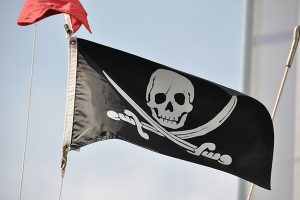 India must implement measures to fortify security of its mercantile marine shipping as it drives exports.
India must implement measures to fortify security of its mercantile marine shipping as it drives exports.
Threats to mercantile marine shipping heightened on the high seas in 2016 despite a decline in global piracy, according to the latest International Maritime Bureau’s annual piracy report. The previous year recorded the highest number of kidnappings with 191 incidents of piracy and armed robbery across oceanic hotspots.
In reality, only a minority of attacks are reported, since voluntary disclosure of such information gives shipping companies a poor image associated with lost cargoes or a perception of weak security management.
The rise of piracy in South Asian waters impacts a third of the world’s mercantile shipping that annually sails through the Strait of Malacca and Singapore Strait. This includes most trade between Europe and China, and nearly all the crude oil transported from the Persian Gulf to major Asian economies like China, Japan and South Korea. Almost 1,30,000 vessels arrive in Singapore each year alone, which amounts to a ship entry into the Strait every four minutes.
The global trade that flows through the Strait of Malacca is a bottleneck only 1.7 miles wide at its narrowest point. Though the bulk of these vessels reach their destination smoothly, the number of attacks is on the rise. For instance, there were 125 pirate attacks reported in the region in 2013, triple the number from 2009. For the same period, the previous year, attacks off the Horn of Africa shrank from 197 to 13 incidents at sea.
Maritime security constitutes three components: security of ships at sea, port security and coastal security. In December 2002, the International Maritime Organisation organised a conference to discuss issues related to security at sea which conceived the International Ship and Port Security (ISPS) code now part of the Safety of Life at Sea convention. Today, international ports of entry must meet ISPS code standards in order for countries to conduct international trade. The ISPS came into effect from July 1, 2004.
Among the features of the ISPS, the Ship Security Alarm System (SSAS) is electronic in nature and designed to transmit a silent alarm system, when activated — to the shipping company and the contracting government via the INMARSAT system on board or an independent satellite broadcasting system — to indicate that pirates have attacked their ship.
This enables the closest coast guard or navy ship to proceed towards the attacked ship to deal with the situation. The SSAS is embedded in two points on board a ship, one of which the crew members have been briefed about and another one which is only known to the ship’s captain.
Ports which form the backbone of mercantile shipping have to be completely ISPS compliant and also Container Security Initiative compliant to ensure that cargo of container ships are pre-screened through non-intrusive inspection for explosives or other contraband that terrorists could use to strike targets.
Coastal security requires the installation of Automatic Identification System (AIS) on all vessels, especially fishing boats. It is electronic bridge equipment that broadcasts various kinds of data to other ships at sea and port authorities in the vicinity. This data may include the name of the ship, its identification number, speed, course etc.
This information helps in positive identification of a ship and enables other ships and port authorities keep track of ships within their vicinity. The AIS enhances security of ships at sea through positive identification of a vessel, especially when the waters are dense with shipping traffic.
Today, marine piracy amounts to organised crime which involves the need to collect information, plan attacks, operate in coordinated teams, often with their own tankers in order to sell stolen cargo, especially oil, to mega pre-arranged buyers. Marine piracy is as old as mercantile shipping itself, and pirate attacks on vessels continue to disrupt trade, which raises vessel security concerns and impacts the operation and insurance costs for ships.
Security management
India has streamlined coastal security management after the 26/11 seaborne terrorist assault which breached maritime security along the Mumbai coastline, to the extent that the coordination between the Indian Navy, Coast Guard and State Marine Police has improved greatly.
However, the security of merchant ships on the high seas remains vulnerable without ISPS compliance. For instance, sea-borne terrorists could hijack an oil tanker and make it a floating bomb that could be rammed into a port to trigger an attack. This blurs the line between maritime terrorism and piracy.
In such a maritime security climate, it is imperative for India to implement measures to strengthen security of its mercantile marine shipping which is integral to the national economy because it drives exports. We have over 110 shipping companies which include corporate names like the state-owned Shipping Corporation of India Ltd, besides other private corporations such as Great Eastern Shipping Ltd, Essar Shipping Ltd and Varun Shipping Ltd India.
These Indian companies, along with several foreign shipping companies, conduct 90% of national trade by volume and 77% in value through the seas. Maritime security assumes importance given the country’s nine coastal states and four union territories are endowed with 12 major ports and 51 non-major ports.
Source: Hellenicshippingnews
